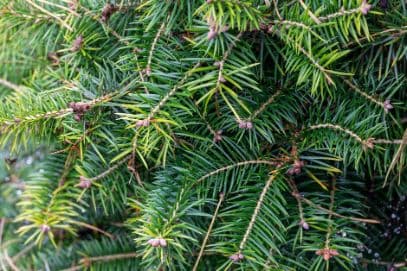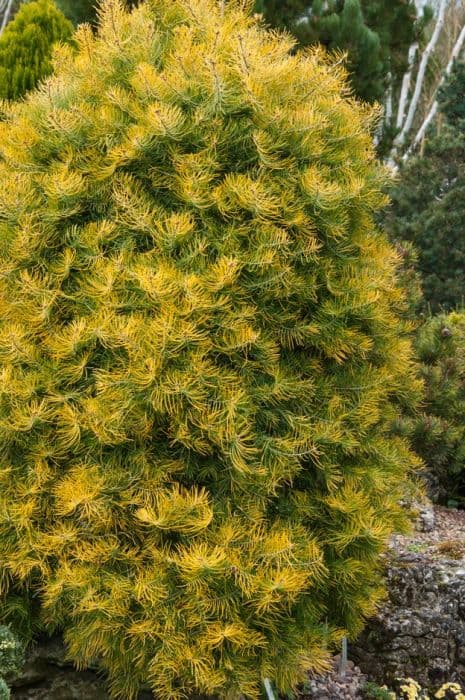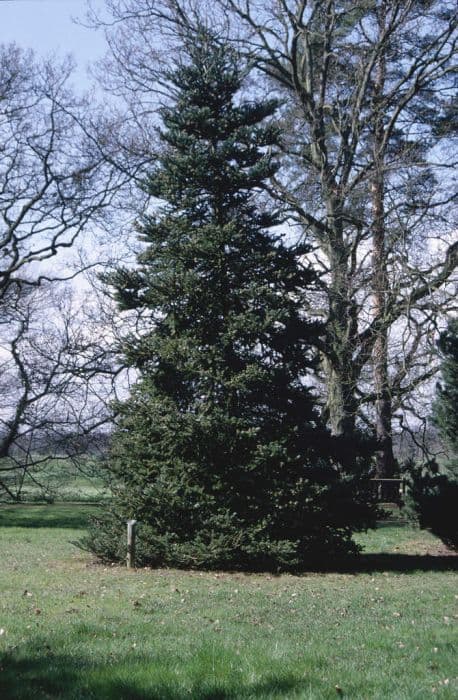Mexican Weeping Pine Pinus patula

ABOUT
The plant known as Pinus patula, commonly referred to as Mexican weeping pine, is characterized by its unique and graceful appearance. It has a distinctive, open and irregular branching pattern which gives it a somewhat 'weepy' or drooping aspect. The needles on this pine are long, thin, and flexible, a bright green in color that adds a fresh look to the tree. These needles are usually arranged in bundles of three, which softly drape from the branches. The bark of the tree is rough and scaly, providing a rich texture that contrasts the delicate appearance of the foliage. The Mexican weeping pine produces cones that are elongated and curved, with each cone having a slightly glossy surface and a woody texture. The cones often hang from the branches, which further enhances the pendulous characteristic of the tree. The overall appearance of the Pinus patula is one that can be described as both elegant and striking, making it a noticeable plant in any landscape where climate conditions permit its growth. Its pleasing aesthetic, combined with its distinct needle and cone features, creates an attractive profile year-round.
About this plant
 Names
NamesFamily
Pinaceae
Synonyms
Mexican Weeping Pine, Patula Pine, Spreading-Leaved Pine
Common names
Pinus patula subsp. tecunumanii, Pinus tecunumanii, Pinus oocarpa var. ochoterenae, Pinus patula var. longipedunculata, Pinus patula var. macrocarpa.
 Toxicity
ToxicityTo humans
The plant commonly known as Mexican Weeping Pine (Pinus patula) is generally not considered toxic to humans. However, many pine species have needles that can be sharp and potentially cause physical injury if handled improperly. Ingesting pine needles, sap, or other parts of the plant in large quantities can potentially cause gastrointestinal irritation or discomfort. Poisoning from pine trees is rare, and symptoms from ingestion may include nausea, vomiting, or diarrhea. It is always best to use caution and avoid eating parts of ornamental plants.
To pets
The plant commonly known as Mexican Weeping Pine (Pinus patula) is not typically known to be toxic to pets. However, ingestion of the pine needles can lead to gastrointestinal upset, such as vomiting or diarrhea, especially if consumed in large quantities. Additionally, the sharp needles can cause mechanical irritation or injury to the mouth or digestive tract. It is advisable to prevent pets from chewing on or ingesting parts of this plant to avoid potential discomfort or injury.
 Characteristics
CharacteristicsLife cycle
Perennials
Foliage type
Evergreen
Color of leaves
Green
Height
65 feet [20 meters]
Spread
25 feet [7.6 meters]
Plant type
Tree
Hardiness zones
7
Native area
Mexico
Benefits
 General Benefits
General Benefits- Erosion control: Pinus patula's root system helps stabilize soil and prevent erosion on slopes.
- Timber production: This species is valued for its wood, used for construction, furniture, and paper products.
- Afforestation: It is often planted to reforest areas that have been cleared or degraded.
- Wildlife habitat: Provides shelter and food for various birds and mammals.
- Ornamental use: With its attractive form and foliage, it's used in landscaping and garden design.
- Climate resilience: It is adaptable to a range of climates, making it useful for reforestation in changing environments.
- Recreational spaces: Often used in creating green spaces for recreational purposes, such as parks.
- Shade provision: Pinus patula can grow to a significant size, offering shade in sunny areas.
- Aesthetic enhancement: Its distinctive appearance can enhance the natural beauty of an area.
- Cultural significance: In some areas, it may have cultural or traditional importance.
 Medical Properties
Medical Properties- This plant is not used for medical purposes.
 Air-purifying Qualities
Air-purifying QualitiesThis plant is not specifically known for air purifying qualities.
 Other Uses
Other Uses- Soil Erosion Control: Mexican weeping pine's extensive root system helps to stabilize soil on steep slopes, thereby preventing soil erosion and landslides.
- Windbreaks: Planted in rows, the Mexican weeping pine can act as a windbreak, protecting crops or infrastructure from strong winds.
- Shade for Understory Plants: Under the canopy of Mexican weeping pine, more delicate plants can thrive, benefiting from the shade and cooler temperatures.
- Habitat for Wildlife: The dense foliage provides shelter for various bird species and small mammals, thus enhancing biodiversity.
- Christmas Trees: Its symmetrical shape and evergreen qualities make the Mexican weeping pine suitable for use as a Christmas tree in some regions.
- Amateur Woodworking: The wood of Mexican weeping pine can be used for small woodworking projects by hobbyists due to its workability and moderate density.
- Noise Barrier: When planted densely along highways or around residential areas, the trees can act as an effective noise barrier.
- Cultural Significance: In certain cultures, Mexican weeping pine may be used in ceremonies or as a part of traditional rituals tied to the natural world.
- Photography and Art: The picturesque nature of Mexican weeping pine makes it a popular subject for photographers and artists seeking to capture natural beauty.
- Education and Research: Mexican weeping pine can be used in forestry education and research programs to study its growth habits, ecological role, and response to environmental changes.
Interesting Facts
 Feng Shui
Feng ShuiThe Mexican Weeping Pine is not used in Feng Shui practice.
 Zodiac Sign Compitability
Zodiac Sign CompitabilityThe Mexican Weeping Pine is not used in astrology practice.
 Plant Symbolism
Plant Symbolism- Resilience and Strength: The Mexican Weeping Pine, as many other pine species, symbolizes resilience and strength due to its evergreen nature and ability to thrive in challenging conditions.
- Longevity: Pines often represent longevity and eternal life because they are long-lived trees, with some species living for hundreds or even thousands of years.
- Peace: In some cultures, pine trees are a symbol of peace, serenity, and tranquility, likely because of their enduring and unchanging nature.
- Wisdom: The pine tree's long lifespan also lends it the symbolism of wisdom and knowledge accumulated over time.
 Water
WaterThe Mexican Weeping Pine should be watered deeply and infrequently to mimic its natural habitat, where rainfall can be scarce. Established trees do well with a deep watering every two to four weeks during dry periods, with each watering consisting of about 10 gallons per inch of trunk diameter measured at knee height. Newly planted trees require more frequent watering, such as once a week, to establish their root systems. During the winter, watering can be reduced as the pine's growth slows and the weather provides sufficient moisture. Always check the soil moisture before watering to avoid overwatering, as this species is prone to root rot if the soil remains waterlogged.
 Light
LightThe Mexican Weeping Pine thrives in full sunlight and requires a minimum of six hours of direct sun per day to grow properly. The best spot for this tree is an open area away from taller structures or trees that might shade it. Ample sunlight is crucial for the healthy development of needles and the overall vigor of the tree.
 Temperature
TemperatureThe Mexican Weeping Pine prefers cooler mountain climates and does well in temperatures ranging from 20°F to 75°F, although it can withstand temporary dips down to as low as 0°F. The ideal temperature range for optimal growth is between 50°F and 70°F. It is important to avoid extreme heat, as temperatures consistently above 80°F may stress the tree.
 Pruning
PruningThe Mexican Weeping Pine occasionally requires pruning to remove dead or damaged branches, improve its shape, and maintain its overall health. Pruning should be done in late winter or early spring before new growth starts. It's important not to prune too often or too much, as pines do not regenerate from old wood like many other trees do. Removal of competing leaders on young trees can help establish a single, strong trunk.
 Cleaning
CleaningNot needed
 Soil
SoilFor Pinus patula, commonly known as the Mexican Weeping Pine, create a well-draining soil mix consisting of one part loam, one part peat, and one part sharp sand or fine pumice. The ideal soil pH for this pine should be slightly acidic to neutral, between 5.5 and 7.0.
 Repotting
RepottingMexican Weeping Pines should be repotted every two to four years, depending on their growth rate and the size of their container. Younger trees tend to grow faster and may require more frequent repotting.
 Humidity & Misting
Humidity & MistingMexican Weeping Pine thrives in moderate to low humidity levels typical of outdoor environments and does not require special humidity considerations when planted in its natural, outdoors habitat.
 Suitable locations
Suitable locationsIndoor
Ensure bright light, cool temperatures, and air circulation.
Outdoor
Plant in full sun, provide ample space, and shelter from harsh winds.
Hardiness zone
8-9 USDA
 Life cycle
Life cycleThe Pinus patula, commonly known as Mexican weeping pine or patula pine, begins its life cycle with seed germination, which occurs when conditions are suitably warm and moist. The seedlings establish themselves with a primary root system and grow into saplings, developing needle-like leaves and a characteristic weeping appearance. As the plant matures into a young adult tree, it develops a conical shape and the bark becomes more furrowed. This is followed by a reproductive stage, where it produces both male and female cones; the male cones release pollen which is carried by the wind to fertilize the female cones. The fertilized female cones develop seeds over a period of time, which when mature, are dispersed by wind or animals, leading to the establishment of new plants. Finally, when the tree reaches old age, it gradually declines in vitality, with reduced growth and cone production until it dies, completing its life cycle.
 Propogation
PropogationPropogation time
Spring to Summer
Propogation: The most popular method of propagation for the Mexican weeping pine, or Pinus patula, involves using seeds. Seed collection usually occurs when the cones have reached maturity, which tends to be in autumn. The seeds are extracted from the cones and can be sown immediately or stored dry until the sowing time, which is typically in the spring. The sowing is done in well-drained seedbeds or containers, and it's common practice to cover the seeds with a fine layer of sand or vermiculite to maintain moisture and provide some protection. Germination can take several weeks, and after sprouting, seedlings are nurtured in a nursery setting for up to two years before they are strong enough to be planted out in their permanent locations. It is essential to ensure that the young plants are protected from frost and extreme weather conditions during their formative stages.









